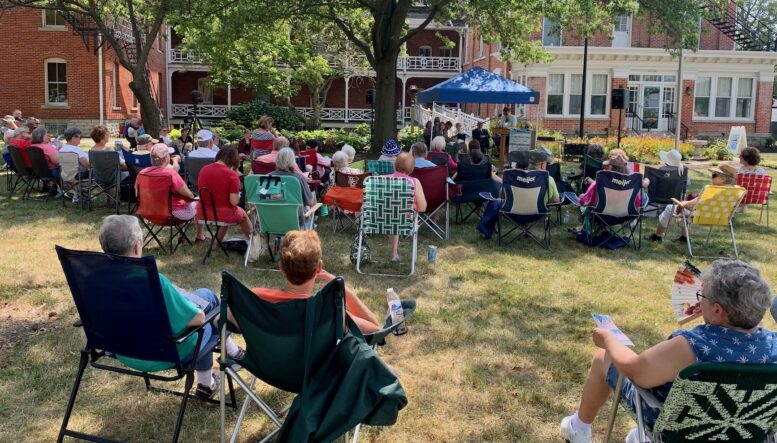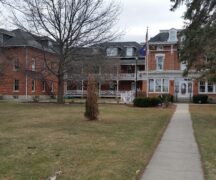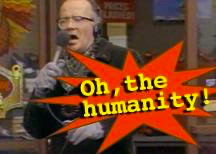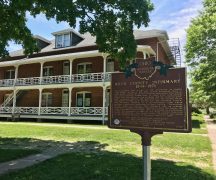By JULIE CARLE
BG Independent News
Kathy Stewart remembers trips from New York to Ohio as a child to visit her grandfather, Cyrus B. Stewart. Their visits often coincided with the Wood County Fair because her grandfather, better known as C.B., was the Wood County agricultural extension agent.
She has fond memories of Bowling Green and her grandparents, C.B. and Ardis Stewart. On Sunday, she had the opportunity to relive some of her grandfather’s historied stories during the 21st Living History Day hosted by the Wood County Museum and presented by DACOR Internet Services.
As the agricultural extension agent and Ohio State University extension faculty member from 1934 to 1961, C.B. was an educator, like all eight Living History Day honorees. Portrayed by Paul Herringshaw, C.B.’s northwest Ohio story started when his first job after graduating in agriculture at the University of Illinois was as the vocational agriculture teacher at Liberty Center High School.
“After several years of working with rambunctious farm boys, I was ready for a change,” he said. He joined the extension office, and together with home demonstration agent Grace Wagner, they worked with Wood County farm families to improve their lives in the midst of the Great Depression.
“Times were tough for Wood County farmers,” he said. The depressed farm economy started prior to the stock market crash of 1929, but his job was to “disseminate research-based information to local farmers and farm families to learn new and more efficient ways of farming,” he said.
Because farmers were resistant to change, building trust was the most important part of his job as an educator. “Once trust and respect were established, the farmers became more receptive to new ideas,” C.B. said.
During his tenure, farmers went from farming with horses to tractors and mechanization on every farm. Crop yields increased through the use of hybrid seeds. “We became better stewards of the land and more efficient at livestock management,” he added.
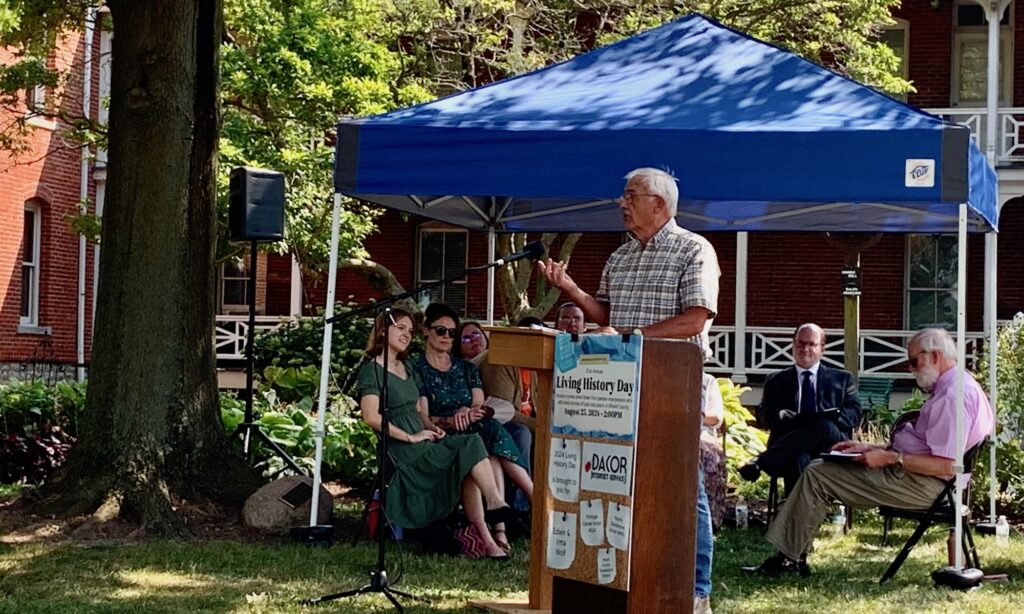
Teaching was a pleasure for North Baltimore teacher Myrtle Bechtel (1893-1983), portrayed by Agatha Wren Hickerson. She admitted that methods of teaching changed over her 50-year career, “some for the good and some for the not so good.” She found that combining the old with the new was effective and allowed students to learn in a method that worked for them.
Music was a subject she thoroughly enjoyed. She taught piano lessons in the summer and established the Children’s Toy Band the first year North Baltimore moved into its new school in 1927—“one of my proudest achievements.”
“We started with tambourines and oatmeal boxes and by 1935, we had tambourines, triangles, cymbals, bells, glocks, and a drum,” she said. They performed for different organizations including the Farmers Institute.
She and her brother, Harold, an industrial arts teacher in the North Baltimore area for 47 years, never married; however, “we both taught the children of others and had an enjoyable and fulfilling life,” she said.
A Bowling Green High School art teacher was the “best thing that happened” to Bowling Green native Ethel Keep Berlin (1910-1997), said Ashley Murang, who shared Berlin’s story.
She found her passion for art after starting art lessons. She studied art at Ohio University and was initially disappointed that she learned more about teaching than about art skills.
“Not that teaching isn’t important, but I didn’t think that was where my skills were,” she said. “But it was a good thing they taught me how to teach, because I did a lot of it.”
She met her future husband Carl Berlin at the Kirian School of Commercial Art in Toledo. She taught at the Toledo School until the art program was eliminated when the Depression hit. “It’s sad, isn’t it, when some teaching has to go and it is always the art? While it’s important to learn, read, write and do figure, it’s also important to learn to tap into your creative side,” she said.
Ethel and Carl raised a family and dreamed of going to New York as artists. “While that never happened, we spent our lives pursuing the love of art and bringing others along on the journey,” she said.
They started the Berlin Art Center in Bowling Green, where Carl taught the adults, and Ethel taught the children. “We created art and taught others to become artists and teachers,” she said. She also had a role in establishing what is now the Black Swamp Players, the local theater group that brings pleasure through the art of storytelling.
Though her life didn’t turn out like she had imagined as a child, she was proud to bring the pleasure of art to others. “I’d like to think my whole life was about learning, teaching and creating,” she said.
The name Arch B. Conklin (1889-1970) may be familiar, not only because a dormitory is named after him on Bowling Green State University’s campus, but also because he was a teacher, superintendent of Bowling Green schools and dean of students at BGSU. Portrayed by Rev. Jeff Schooley, Conklin’s story “extends through the hundreds and hundreds of students that I worked with as an educator for over 50 years,” he said.
Teaching was always his destiny. He liked going to school and enjoyed learning what his teachers at Weston taught him. He was given the chance to teach at a small rural school near Weston after he graduated from high school.
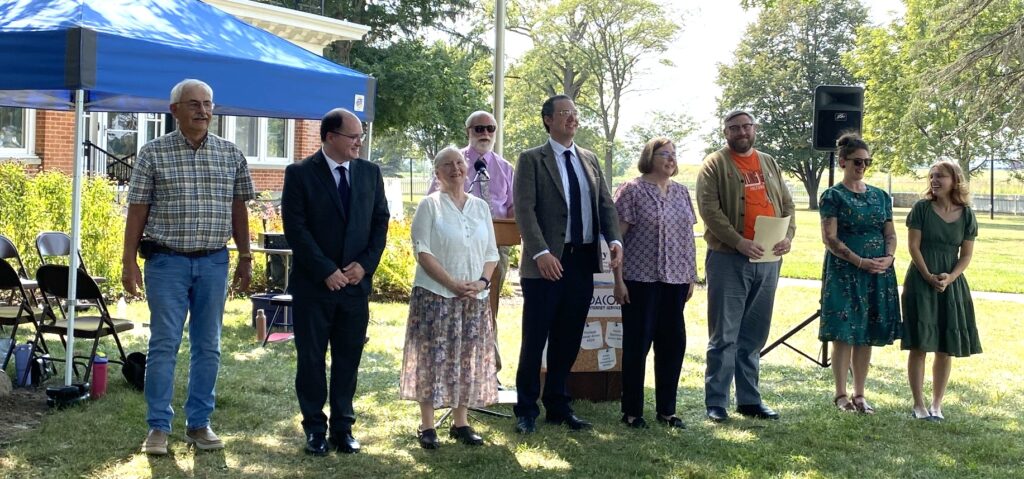
“That’s when I really started learning, meaning I learned how much I didn’t know about teaching. But that was my start toward a lifelong career in education,” he said.
After graduating from Wooster College with an education degree in 1917, he was superintendent at Waterville and Granville before returning to Wood County to be high school principal and then superintendent at Bowling Green schools for 13 years.
His years of teaching prepared him to become dean of students at BGSU, where his job “was to look after the kids and do what I could to help them through their years as students,” he said.
Among his proudest achievements at BGSU was bringing 12 national fraternities and two local chapters to campus. He believed “fraternities were places where students could make friends and connections to help them with their careers after they graduated,” he said.
He also enjoyed living in the town where many of his former students were living and working. “I’ve been around long enough, I can get my teeth pulled, my eyes fitted, my hair cut. I can get legislated upon, preached to and I can payataxes voted through by the kids I helped raise, discipline and educate. I couldn’t ask for a better tribute than that.”
Lolita Thayer Guthrie (1925-2015) was a teacher in her early years but did most of her educating through her service as a volunteer and dedicated genealogist, said Judy Guion-Utsler, who portrayed Guthrie.
Known locally, statewide and nationally as the “cemetery lady,” Guthrie had a penchant for cemeteries and the information that was part of the local history.
She moved to Bowling Green in 1954 with her husband Merle, when he joined the faculty at BGSU.
Together they were interested in bluebirds and started their interest in cemeteries when they added bluebird boxes to many of the local cemeteries.
“My interest in cemeteries preservation melded into a local program for the genealogical society,” she said. The adopt-a-cemetery project was started, and members of the society placed bluebird boxes in cemeteries and monitored them.
Eventually, her focus on cemeteries earned her the title of chair of the Ohio Genealogical Society Cemetery Committee. She and the committee published “Ohio Cemeteries: 1803-2003,” which included information about more than 14,000 burial sites and cemeteries in Ohio.
Thankful for the local genealogical society’s access to the records room and law library created by the Wood County Commissioners, Guthrie and the local organization were responsible for many publications about local lore, including Wood County Probate, cemeteries, Wood County’s role in the Civil War, “and the list goes on and on,” she said.
She earned many awards for her volunteer efforts that included the elementary schools, hospital guild and genealogical societies. She was honored by the National Federation of Genealogical Societies, named Bowling Green’s Outstanding Citizen in 1988 and received the Wood County Good Citizenship Award in 1996.
Though the Living History Day is sponsored by the historical society, the genealogical society has played an important role in the program. “I’m so glad to have had a hand in starting this event and that it continues to this day,” she said.
Anderson Lee told the story of World War II veteran and chemistry-physics teacher and school administrator Bernard Haas (1922-2016).
He grew up in Milton Township, where he attended school and helped on the family farm using a team of three horses to do the lighter farmwork. He worked at various jobs in Bowling Green after high school and eventually was inducted into the U.S. Army Dec. 15, 1942.
While serving overseas, he was hit in the leg by a 50-caliber anti-aircraft gun. The bullet didn’t tear through the other side of his pants, so he was able to save the bullet from the wound.
After he was discharged in November 1945, he returned to northwest Ohio and eventually went to BGSU on the GI Bill. He started in the pre-dental program but found out the GI Bill wouldn’t pay for dental school.
“I switched to chemistry and physics since I had already taken the science courses, and I ended up becoming a teacher,” he said.
He finished the pre-dental program, “but I was happy with teaching high school and never explored the possibility.”
He taught at Morenci High School for two years and then moved to Napoleon where he taught until 1968. He furthered his education of math and physics through a National Science Foundation grant at Washington State University, then moved to Fremont where he supervised curriculum development for the Sandusky County School System for 16 years until he retired in 1983.
“I really liked my years of teaching, but I’m not sure I could have coped with the breakdown in discipline that occurred throughout the 1960s,” he said.
Esther Hayhurst (1908-1996), the Bowling Green High School history teacher who was named the1966 Ohio Teacher of the Year and the 1977 Bowling Green Outstanding Citizen, came from a family of teachers and was destined to teach, said Wendy Guion, who portrayed Hayhurst on Sunday.
She and her older sister Ruth were both BGSU graduates; Ruth graduated in 1929 and Esther in 1930.
Her first job was to teach history and social studies at Defiance High School. “The first year wasn’t a good year, nothing seemed right,” she said. “I didn’t know how to manage the students and decided to quit. But when I told my father, he sat me down and reminded me that teaching was in my blood and that teachers always have bad years now and again, especially when they are starting out.”
She returned to Defiance and was glad she did. As time went on, she learned what worked in the classroom and she grew to love teaching history to teenagers. “It was fun and I came to enjoy the time I spent with my students,” she said.
She also taught education majors part-time at BGSU. Hayhurst continued her studies at Case Western Reserve, and universities in Wisconsin, Maine and Duke “because there is always one more thing to learn,” she said. “I always took everything I learned back to the classroom.”
Over the years, she had many student teachers in her classroom, but the most notable was Dave Wottle, who won the Olympic Gold Medal in the 800-meter run in 1972. Known for his trademark ballcap, he could not wear his running attire in the classroom. She remembered a day when he was writing on the blackboard, and she noticed a price tag on the suit he was wearing. She discreetly snipped off the tag “without him ever knowing,” she said.
In addition to the awards she received for teaching, she was also awarded a Fulbright Fellowship to study at Sophia University in Tokyo.
“I was honored, but that is not why I chose to become a teacher,” she said. “My biggest reward came from the students—the students who would struggle in the classroom, and I was able to help them understand the material and increase their grades. Students who were so smart and quick who ended up teaching me some things. They are the rewards I cherish.”
Clayton C. Kohl (1875-1938) made an impact as an educator at Bowling Green State University, said portrayer Tom Edge. At BGSU from 1920 to 1938, he was the first faculty member to hold an earned doctorate.
Born in Perrysburg, he graduated from Ohio State University and became a teacher. He served as superintendent at Mechanicsburg and then went on to earn his master’s degree and doctorate from New York University.
“I had a lot of varied interests,” he said. “I wanted to know ‘How does this work’ and ‘Why did that happen?’”
His education and previous jobs prepared him for the work at BGSU. “Bowling Green Normal College never intended to be only a two-year teacher preparation program,” he said. With his advanced degrees, he was chosen to help grow the school.
“The process was long, but eventually education and liberal arts become four-year programs,” he said. “I was determined that BGSU would have a strong graduate school.”
That is his legacy, though he died unexpectedly in 1938. All of his papers are archived at the Jerome Library on BGSU’s campus.
Additional support for this program was provide by Portage Center Arbor Gleaners 524, North Baltimore Gleaners #461 and Wood County Genealogical Society.

